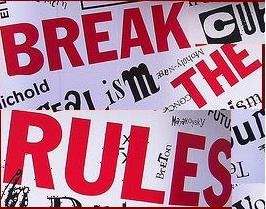This is a post I’ve been wanting to write for a while now, and ironically, the reason I haven’t is because I want it to be perfect. I’m disobeying the damned title of the post! So here, finally, we go.
There is something that has happened so often in my time improvising, or that I’ve heard so often, that I’ve come to think that if there is one true rule of improv, it is this: Fail big! I’ll give some examples.
***
1) At the most recent SFIT Dust-up on closing night, I was fortunate enough to be grouped with Mike Christensen, Kate Jaeger, and Mike Murphy of Jet City Improv (Seattle); Joel Dale of Improsia (Seattle); and Antonella Serra and Enzo Zammuto of B-Teatro Boxeattori (Turin, Italy). For the SFIT Dust-up, each group has a bit over ten minutes to decide on a format before performing. Kate said that she wanted to do a set in which we spoke in whatever language we wished, especially for the Italian performers to be allowed to perform in Italian. We wound up speaking five different languages (if dialects count as languages) over the course of 12 minutes: English, Italian, French, Klingon, and Boomhauer Mushmouth. And it was a blast.
By far my favorite part was the final scene. In the wings just before they went on, Enzo nudge Kate and whispered, “Me English, you Italian.” And out they went. Enzo spoke nothing but English and Kate spoke nothing but Italian. And… IT. WAS. AWESOME. I could describe the scene, but are descriptions of past improv scenes ever truly satisfying? Trust that it was incredible. I mean, just look at that picture (for more of Todd’s amazing pix, go here).Right?!
On the way out of the theater after the show, I said to Kate how happy I was that she’d suggested the format. She commented that it was the most scared she’d been doing improv in years. And we both looked each other with huge grins on our faces and asked each other something along the lines of, “How awesome is that?!”
I hope you, reading this, know Kate. But if you don’t, know this: she’s a Seattle treasure. An awesome human being, an award-winning actress, a brilliant singer, and one of the best improvisers in town. She’s not someone you would think of being afraid on stage. And yet… having had that moment doing improv made her positively giddy talking about it afterward.
2) This one’s shorter, I promise. Ian Schempp? Know him (of course you do; he’s one of the writers here)? Awesome improviser, great improv teacher. Had him for a long-form essentials class a few years back. The single thing I remember best about that class? He said (and I may be paraphrasing), “I’d rather do a terrible show than a mediocre one. Because if it was terrible, it meant I was trying something. If it was mediocre, I was just playing it safe.”
Hell, yeah.
3) A couple years back, Joe Koenen directed “The Adventures of Gilbert & Sullivan.” An improvised light operetta. When auditions were announced, I thought, “That sounds terrifying.” And then thought, “Well, that means I should audition.” And I did. And got cast. And made the promise to myself every rehearsal to fuck up as big as I possibly could. Sing a patter song as fast as possible. Set up really difficult rhymes. While dancing. Et cetera. And others were doing the same. Almost every rehearsal, we did a patter circle. And in almost every patter circle, at least once the chorus was “La la la la, la la la la, fuck fuck fuck fuck fuck.” Because we’d gone big and failed. And it was the most fun I’ve had in any improv rehearsal process. And the run was an absolute gas. AND we all gained improv levels during that process at an absurd clip.My biggest regret about that show was when we revived it for festivals in Honolulu and Seattle. I felt like I’d gotten to a certain level, and owed it to the audience to hit that level in shows. So I played much, much safer than I did in the original run. And while I thought others in the cast did awesome work in those festival shows, I’m still angry at myself for striving for “good enough” instead of “terrifying.”
***
I could cite example after example of cases in which I’ve seen improvisers shoot for something bigger than they thought they could do, and it didn’t matter whether they reached it or not. One of the many beauties of improv is that failures, at least if they’re on a grand enough scale, are delightful. Failures, to use improv nomenclature, are offers. Brilliant offers. AND they teach us and make us better at our craft?! They’re like snake oil that actually works.
Trust me on this. Want to get better? Challenge yourself to fail. Feeling like you’re in a rut? Oh my fucking god, PLEASE challenge yourself to fail. Try to speak too fast, to make up iambic pentameter, to play characters that no right-minded director would ever cast you in. Do it, do it, do it.
Fail big.



